Eyes on the Bay: Looking Back at Winter (February) 2021
Eyes on the Bay Resumes for 2021
Whether you like to boat, fish, swim or just enjoy Maryland’s amazing seafood, we know there are many folks out there who have bay waters running through their veins and like to keep their finger on the pulse of bay conditions.
 Every few weeks, the experts with the Maryland Department of Natural Resources comb through Maryland’s extensive network of monitoring data to find the key information to help you better understand conditions in the Chesapeake Bay. You don’t even need a boat!
Every few weeks, the experts with the Maryland Department of Natural Resources comb through Maryland’s extensive network of monitoring data to find the key information to help you better understand conditions in the Chesapeake Bay. You don’t even need a boat!
*Monitoring update – Due to COVID-19, crews are adhering to social distancing and safety protocols to provide resource managers, scientists, and the public with timely water quality results that drive Chesapeake Bay restoration.
Climb aboard the Eyes on the Bay, toss off the dock lines, and let’s go for virtual cruise on Maryland’s waters!
Sincerely,
Your friends at DNR’s Eyes on the Bay monitoring program and Fishing and Boating Services
Chilly Winter Water Temperatures Were Average – Bay water temperatures for February were average, and held in the upper 30s. Typically, bay water temperatures in February are the coldest of the year. While surface waters continued to cool through the winter, bottom waters were slightly warmer than surface waters. This pattern of slightly warmer waters at the bottom continued throughout the winter, providing overwintering refuge for many bay fish.
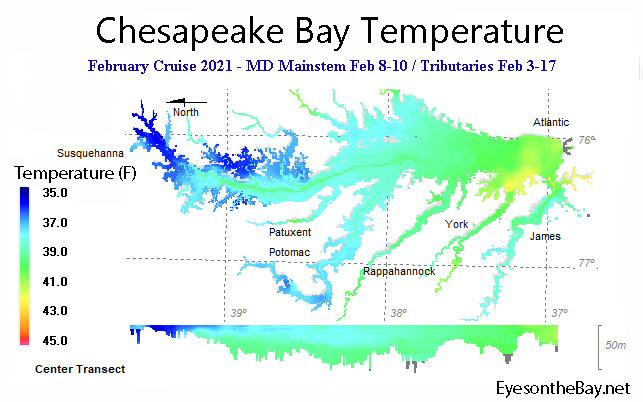
Data source: Maryland Department of Natural Resources Eyes on the Bay. Funding for monitoring: US Environmental Protection Agency Chesapeake Bay Program and state sources.
Bay Salinities Are Variable throughout Bay – Due to variable rainfall amounts throughout the watershed, surface salinities in February 2021 were above average when compared to historical February surface salinities above the Bay Bridge, and in the upper Patuxent and Potomac rivers. Surface salinities in the lower Eastern Shore were below average from higher than normal rainfall amounts.
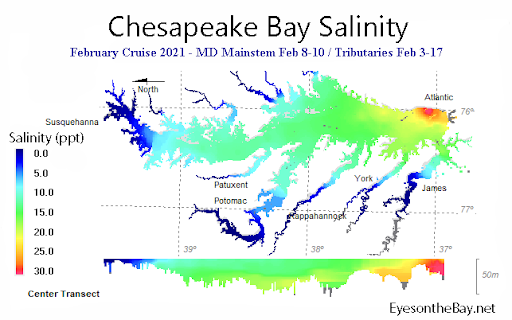
Data source: Maryland Department of Natural Resources Eyes on the Bay. Funding for monitoring: US Environmental Protection Agency Chesapeake Bay Program and state sources.
Plentiful Oxygen throughout the Bay – Since the waters were mixed from surface to bottom or “turned over” in mid-October, there has been ample oxygen from surface to bottom for the bay’s organisms through the winter. To see recent oxygen levels by depth, check the “Do not fish below this depth map.” For oxygen forecasts, see VIMS Depth to 3 mg/l map.
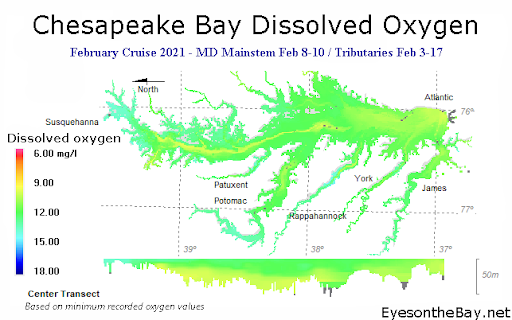
Data source: Maryland Department of Natural Resources Eyes on the Bay. Funding for monitoring: US Environmental Protection Agency Chesapeake Bay Program and state sources.
For more detailed and up-to-date Chesapeake Bay conditions in your area, please continue to check out Eyes on the Bay, your one-stop shop for information on Maryland’s bay waters. Drop us a line with comments or suggestions.
Neighborhood Watch
 Blue crabs continue winter sleep – Since about the third week of November when the water temperatures dropped to 50 degrees, blue crabs have been buried in the mud along the deeper channel edges to wait out the winter months. Preferred areas for the males are in waters with salinities from 3ppt to 15ppt, while female blue crabs prefer areas greater than 10ppt. Learn more.
Blue crabs continue winter sleep – Since about the third week of November when the water temperatures dropped to 50 degrees, blue crabs have been buried in the mud along the deeper channel edges to wait out the winter months. Preferred areas for the males are in waters with salinities from 3ppt to 15ppt, while female blue crabs prefer areas greater than 10ppt. Learn more.
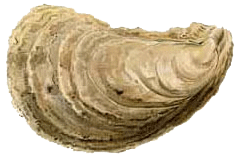 Oysters hibernate – With bay temperatures in the low 40s, oyster growth ceased. Oysters hibernate when the water temperature drops below 41 degrees. At these cold water temperatures, there is no oyster disease activity. With the return to normal salinities, conditions for oysters living in the upper bay and upper tributary areas have improved. Learn more.
Oysters hibernate – With bay temperatures in the low 40s, oyster growth ceased. Oysters hibernate when the water temperature drops below 41 degrees. At these cold water temperatures, there is no oyster disease activity. With the return to normal salinities, conditions for oysters living in the upper bay and upper tributary areas have improved. Learn more.
 Striped bass wait out cold weather – With water temperatures in the low 40s, resident striped bass remain in their overwintering areas in deeper waters, which are slightly warmer and provide more stable temperatures. Typical overwintering areas included deep areas protected from heavy current such as bridge pilings, points, and holes. The larger, nonresident striped bass that spawn in the Chesapeake Bay are moving southward down the Atlantic coast towards their spring spawning ground s. Learn more.
Striped bass wait out cold weather – With water temperatures in the low 40s, resident striped bass remain in their overwintering areas in deeper waters, which are slightly warmer and provide more stable temperatures. Typical overwintering areas included deep areas protected from heavy current such as bridge pilings, points, and holes. The larger, nonresident striped bass that spawn in the Chesapeake Bay are moving southward down the Atlantic coast towards their spring spawning ground s. Learn more.
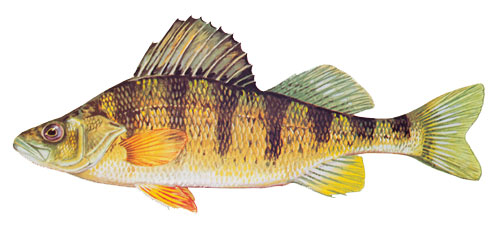 Yellow perch on the move – Adults are present in schools in fresher ( less than 7ppt), deeper (greater than 20 feet) bay waters or downstream portions of rivers, which are warmer and provide more stable temperatures. Cued by light and water temperatures, adult yellow perch begin to migrate in large schools from the lower parts of the tributaries to the upper regions (0 to 2.5ppt) in search of suitable spawning habitat (shallow water around vegetation and woody debris). Learn more.
Yellow perch on the move – Adults are present in schools in fresher ( less than 7ppt), deeper (greater than 20 feet) bay waters or downstream portions of rivers, which are warmer and provide more stable temperatures. Cued by light and water temperatures, adult yellow perch begin to migrate in large schools from the lower parts of the tributaries to the upper regions (0 to 2.5ppt) in search of suitable spawning habitat (shallow water around vegetation and woody debris). Learn more.
 Bay grasses prepare for spring – Since December, when the bay waters cooled to the low 40s, most types of submerged aquatic vegetation (bay grasses) have senesced or died back for the winter. But, seeds and overwintering tubers remain dormant in the sediment as they prepare for spring. Some species, like milfoil and eelgrass, a higher salinity, cooler water species, may still be visible. Learn more.
Bay grasses prepare for spring – Since December, when the bay waters cooled to the low 40s, most types of submerged aquatic vegetation (bay grasses) have senesced or died back for the winter. But, seeds and overwintering tubers remain dormant in the sediment as they prepare for spring. Some species, like milfoil and eelgrass, a higher salinity, cooler water species, may still be visible. Learn more.
Key Links
Maryland DNR 2021 Photo Contest Now Open – The Maryland DNR is now accepting entries for its annual photo contest. Photographers, novice or professional, can enter for the chance to win cash, park passes, and other great prizes.
Click Before You Cast – Know more, catch more fish. For the full weekly fishing conditions summary and more detailed and up-to-date fishing conditions in your area of the bay, be sure to check out Eyes on the Bay’s Click Before You Cast.
Chesapeake Bay Hotline – “It’s the 911 of the Chesapeake Bay!”
As always, call the Chesapeake Bay Hotline at 1-877-224-7229 to report any of the following:
Boating accident or reckless activity | Fish kill or algal bloom | Floating debris that poses a hazard to navigation | Illegal fishing activity | Public sewer leak or overflow | Oil or hazardous material spill | Critical area or wetlands violation | Suspicious or unusual activity


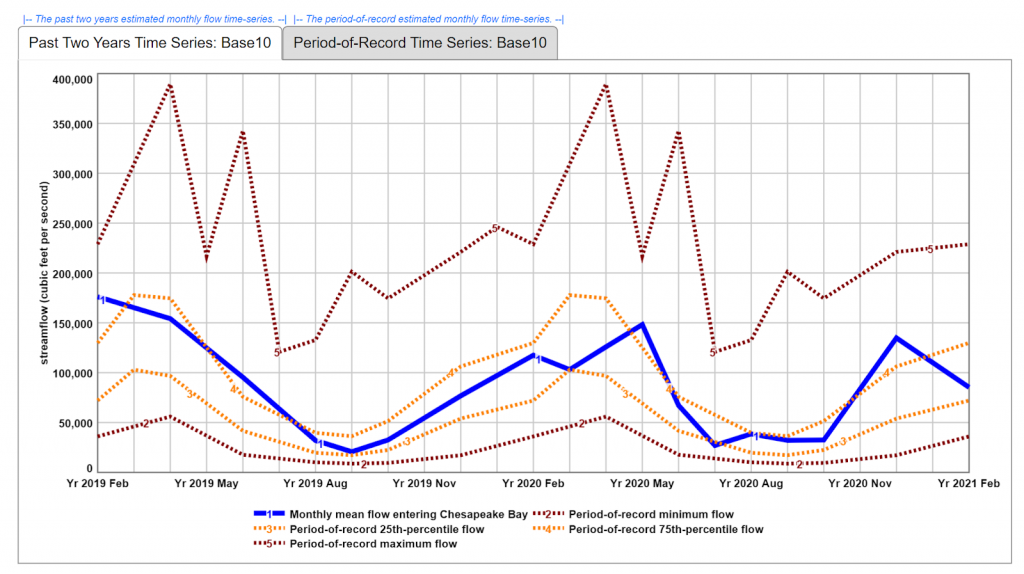
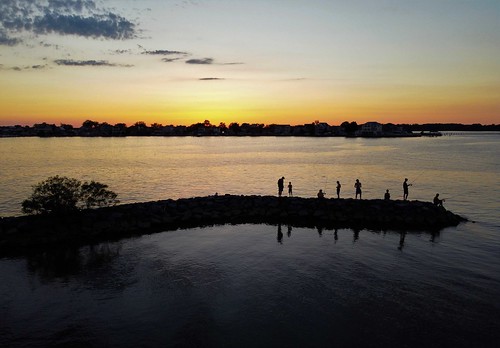
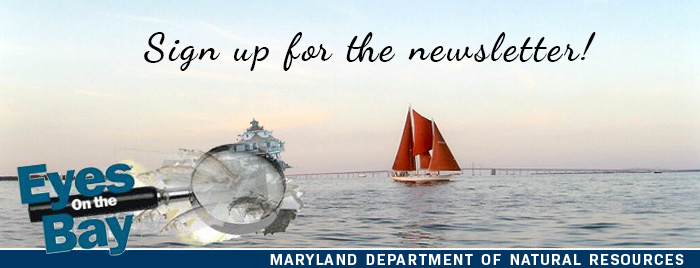
 1-888-373-7888
1-888-373-7888 233733
233733